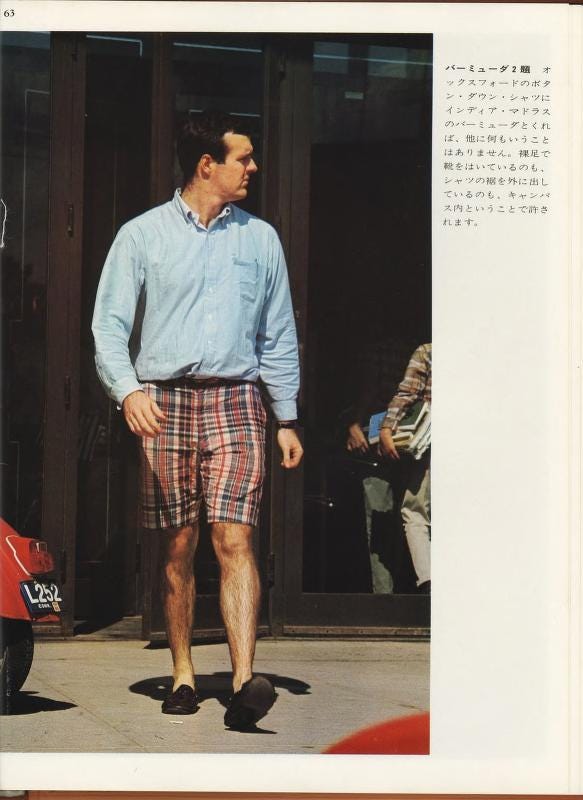The issue, I think, with “sprezzatura” is that it is still fundamentally peacocking. Even with your loose tie, and your unpressed whatever there is great attention being made to having an outfit. That’s not what I’m on about, today I want to talk about anti-style, something as alluring as it is fundamentally paradoxical.
Welcome to this week’s meeting of The Prep Club, check last week’s issue of THE RADAR here, for a rant about fashion YouTube, among other queries vaguely shoehorned into the world of collegiate fashion. Also make use of The Directory, new this week:
Marman of San Fransisco - Now defunct, produced traditional sack jackets in Harris Tweed, including patch pockets and hook vents.
College Hall - Now defunct, tailored collegiate clothing for department stores through the 1960s, produced relaxed ivy tailoring as well as shetland knitwear.
The North Face - Now ubiquitous, and not without unsavoury connotations depending where you are from; however, vintage, or modern Japanese market examples are excellent. Look for brown labels for both.
THE DIRECTORY
Please find below The Prep Club’s Directory, an as-comprehensive-as-possible, alphabetised guide to retailers and labels
Small Favour: If you wouldn’t mind, please share this post, or the club as a whole, with a friend who you think might be interested, it would mean a whole lot. Please also subscribe if you haven’t yet, again, it makes a big difference.
This comes from a couple of earlier meetings of mine, particularly In Defence of the Polo Oxford. I keep coming back to this idea:
“No-one photographed in Take Ivy was getting a fit off, they were just dressed”
In a way, today’s meeting is the Yin to that article’s Yang, it’s an inverse take on the same idea. That was attitude over aesthetics, this is all about visuals.
What the hell even is anti-style?
“Antistyle” exists in graffiti cultures to refer to a sort of deliberately underdeveloped, unconsidered, and cheaply made approach. My appropriation of the term fits within this pretty well, with a key distinction. What I’m trying to get at is an idea of putting outfits together with total abandon, and yet carrying it off in a sort of inexplicable manner.
This is what we’re seeing on the pages of Take Ivy, the young men in those photos were not aesthetes like the preppies that followed them, they were just college kids, throwing on whatever was in their wardrobe so they could get to class. Looking past the rose tinted sheen on the paper, a lot of these looks just wouldn’t fly today, not just because they’re not on trend, but because they look a little daft.
Take this guy, in his huge madras shorts, blue OCBD that doesn’t match, and black loafers which run too formal for the rest of the ensemble, by my usual metrics of cohesion and silhouette this isn’t a fit, and yet, for some reason it just works.
Or check how short those pants are, they plain don’t fit, and it doesn’t matter a cent. These guys even said it at the time, when asked about their clothes by the makers of Take Ivy they’d say they thought very little about them¹.
I had a go at capturing the same energy, and whilst I could probably spring into some sort of analysis of why this shouldn’t work, the clashing of the patterns etc., I feel like that would be the absolute antithesis of the point here. We’re not talking about nonchalance, we’re taking about flat out not giving a flying f*ck.
So why does it work?
Here’s the thing, if you want to pull this off I think you need very, very good clothes. The details need to be nailed down, collar rolls perfect, loafers in beautifully thrashed cordo (I haven’t reached this one yet), proper vintage sport-coats. That’s the sitch our Ivy Leaguers were in, they didn’t really think about how they were dressed, but they had wardrobes stuffed with J. Press and Brooks Brothers. They rather stumbled in to looking as good as they did because clothes were just better back then, and they were buying the good sh*t too.
This is something I think about a lot when we look to these style icons of bygone eras [McQueen, Newman, Kennedy, Davis, y’know the drill] and why I don’t think we’ll ever quite get back to what they had. They just had it a little easier. They did’t have to agonise on forums, pour over reference photos, or set up EBay saved searches, they bought clothes that were readily available, and that just looked better than the ones we get now. I keep going back to it, but collar roll is the biggest one for me, I never thought I’d become such an evangelist for it but these days it’s a bit of an obsession. Modern shirts with a properly sized collar are so damned hard to come by, and you’ll never just stumble into them in the same way these anti-stylers did. The same goes for selvedge denim, that’s just how 501s were made back in the day.
This is all to say that, the guys in Take Ivy look cool in part because they don’t care how they look, but also because they didn’t have to care, they just had very very good clothes.
So is this even possible now?
I’m inclined to say yes and no, it’ll never happen naturally, the way it did in the past. Fashion is just too niche now, you’ll never end up with a wardrobe full of truly beautiful clothes without also learning along the way how to style them. Besides, by telling you about this I’ve stripped away any chance you had of not thinking about anti-style itself, though let’s be honest if you’re here you’re already thinking way too hard about your outfits.
That said, and returning to the point of my other article, there’s an attitude of sorts that can be adopted, as long as you trust your wardrobe. Lean into the fact that you own excellent clothes, and throw them on without looking in the mirror, just carry it off, I believe in you. You’re demonstrating taste in acquisition and disregard in styling. Of course, you then get into a bit of a twist with trying too hard to not try too hard, this is why I reckon not looking in the mirror is the move, avoid studied nonchalance by not studying at all.
Closing Thoughts
With all this said, I think passion is hip, that it’s always worth being into things deeply, caring deeply. I think these days anti style only has value against the backdrop of a great love for fashion, it’s a way though to let it go lightly, to set oneself free from the perception that every outfit has to be Instagrammable as f*ck, whilst keeping a hobby which is a lot of fun. Sometimes you’ve just got to get on with shit, and on those days I think you need a wardrobe you can trust to simply throw stuff on with abandon, knowing you’ll have a fit anyway.
Prep Club adjourned, catch you soon.
¹ Ametora, David W. Marx
Conviction / Militora / Three’s a Crowd / A Colour for Summer
Hello! Welcome back to THE RADAR, The Prep Clubs’s fortnightly digest for interesting bits and pieces in the sphere of collegiate threads. You can attend last week’s meeting here, for discussions of regional specialty in fashion.












I would say that what you just described is how sprezzatura was described by Castiglione.
You have to study how to act and what to do in private in order to make it look nonchalant in public.
In dressing study what to wear extremely well so that you can do it effortlessly.
It is a pet peeve of mine how sprezzatura is defined in modern day menswear and how it feels like exactly the opposite of what was meant:
"an easy facility in accomplishing difficult actions which hides the conscious effort that went into them"
Deliberately wearing something "wrong" is the exact opposite of hiding the conscious effort.
Well said!
True sprezzatura was originally about making mastery look natural and it’s hard to strike the balance between truly relaxed and obviously trying too hard.